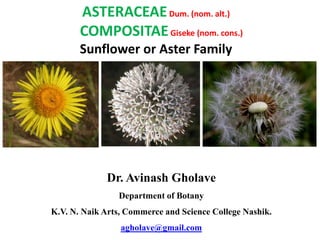
Sunflower Family Document: Key Facts and Uses
- 1. ASTERACEAEDum. (nom. alt.) COMPOSITAEGiseke (nom. cons.) Sunflower or Aster Family Dr. Avinash Gholave Department of Botany K.V. N. Naik Arts, Commerce and Science College Nashik. agholave@gmail.com
- 2. Bentham & Hooker Division: Phanerogams Class : Dicotyledons Subclass :Gamopetalae Series: Inferae Order: Asterales Family: Asteraceae
- 3. Geographical distribution: Largest family of flowering plants. It is cosmopolitan and distributed almost every corner of the world in every habitat. World: 1,528 genera and 23,840 species India: 166 genera and 803 species Maharashtra: 60 Genera and 143 Species
- 5. Habit: Herbs, shrubs, scandent shrubs (Vernonia elaegnifolia) or trees (Vernonia arborea, Leucomeris). Root: Taproot and tuberous (Dahlia). Stem: Erect or prostrate (Grangea), or armed (Echinops) or glandular hairy and winged (Sphaeranthus), or tuberous (Helianthus tuberosus), or succulent (Vernonia), or with milky latex (Sonchus), or even reduced (Elaephantopus). Vernonia arborea Dahlia Helianthus tuberosus Sonchus ElaephantopusSphaeranthus
- 6. Leaves: Usually exstipulate, alternate (Parthenium), or opposite (Eclipta), or in rosettes (Elaephantopus), usually simple or pinnately lobed (Dahlia) or lyrately pinnatifid (Sonchus). Leaves sometimes spinescent (Echinops) or reduced to scales (Haplophyllum). Parthenium Eclipta Elaephantopus Dahlia Sonchus EchinopsHaplophyllum
- 7. Plants gynomonoecious (with bisexual disk florets and female ray florets: (Helianthus), or monoecious (only with bisexual disk florets: Vernonia), or dioecious (only with female ray florets: Dahlia). Helianthus Vernonia Dahlia
- 8. Inflorescence: Capitulum, basically an acropetal racemose inflorescence. Capitulum is sometimes 1-flowered (Echinops), or few-flowered (Nanothamnus), or many-flowered (Helianthus), usually subtended by an involucre of 1-many whorls of free or variously connate bracts, known as phallaries. Echinops Nanothamnus Helianthus
- 9. Flower: Flowers bracteate (the bracts forming an involucre in one to several series), regular and irregular (often combining central actinomorphic and marginal ‘ray’ florets is zygomorphic). Calyx: Sepals 2–30, of scales or bristles constituting the ‘pappus’, 1 whorled, usually adnate to ovary persistent with valvate aestivation, calyx sometimes absent (Ambrosia, Siegesbeckia).
- 10. Corolla: Petals 1–3 in ray florets and 4–5 in disk florets, gamopetalous, variously coloured, with valvate aestivation. Corolla is usually represented by one or two of the three types: • Tubular or Discoid Corolla: Petals 5, with conspicuous tube and short lobes with valvate aestivation. • Ligulate or Ray Corolla: Petals 1- 3, represented by short teeths at tip and a very short tube. • Bilabiate corolla: Modified from a tubular corolla and having a 3- lobed upper lip and 2- lobed usually slender, recurved lower lip. Tubular Ligulate Bilabiate
- 11. Androecium: Stamens 3–5; epipetalous, opposite to sepals and alternate to petals, syngenesious. (In ray floret absent). Anthers cohering forming a tube or cylinder around the style; basifixed; dehiscing by longitudinal slits; usually appendaged. Gynoecium: Bicarpellary, syncarpous unilocular, inferior ovary. Epigynous disk usually present around the base of the style. Styles 2; partially joined stigmas 2. Ovules single in each locule on basal placentation.
- 12. Pollination: Entomophilous. Pollination mechanism conspicuously specialized via stylar modification. Fruit: cypsella. Seed: Seeds non-endospermic. Dispersal: Specialized by pappus calyx, which show a parachute mechanism (wind dispersal) but some time hooks or spines attach to cloths and animal. Floral formula: Disc: Br ⊕ ♀ K (2–∞) C(4–5) A(4–5) G(2) Ray: Br † ♀ K(4–5) C(3–5) A0 G(2)
- 13. • Usually herbaceous stem • Leaves usually alternate • Capitulum type of inflorescence surrounded by involucral bracts (phyllaries) • Calyx represented by pappus • Stamens show syngeny; anthers united forming a cylinder • Ovary inferior • Fruit a cypsela and seeds non-endospermic
- 14. 1. Food: Leaves of Lactuca sativa are used as salad. The roots of Helianthus tuberosus are edible. 2. Oil: The seeds of Helianthus and Artemisia yield oil. 3. Rubber: It is obtained from Solidago laevenworthii and Taraxacum. 4. Insecticide: The capitula of Chrysanthemum roseum and C. cinerriefolium are dried, powdered and used as insecticide.
- 15. 5. Ornamental: Zinnia, Dahila, Cosmos, Chrysanthemum, Calendula, Aster, Helianthus etc. are well known garden plants. 6. Medicinal: Artemisinin is isolated from the plant Artemisia annua and used against malaria (for this work Tu Youyou and co-authors awarded Nobel Prize in Medicine) and today this antimalarial drugs used for treatments of Covid-19. The roots of Taraxacum used in bowel disorders. The juice of Emillia sonchifolia leaves has cooling effect and is used in eye inflammation and also for night blindness. Eclipta alba used as tonic in spleen enlargement. Centipeda orbicularis is used in cold and toothache.
- 16. Taxonomists have assigned different systematic position to the family. Bentham and Hooker placed the family under Gamopetalae just after Rubiales. Hutchinson did not treat the family as the last evolved and put the Asterales under the 6th series far before the last series Laminales; but he placed it near Rubiaceae. Engler and Rendle placed it as the highest evolved dicot family. If polyphyletic origin of the family is taken into account it may be assumed that the origin of Rubiales and Asterales is from Apiaceae, which shows a tendency of aggregation of flowers and reduction of calyx lobes, carpels and ovules. Takhtajan traces the origin of Campanulales, Calycerales and Asterales from the order Gentianales. He also relates Asteraceae with Calyceraceae and other families of the other Campanulales.
